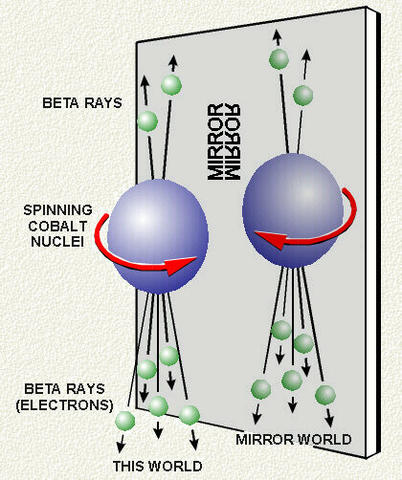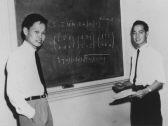Parity: What's Not Conserved?
Paul Forman, Curator for Modern Physics
National Museum of American History, Smithsonian Institution
Washington, DC, January 1982

The ellipsoid on the left represents a large number of cobalt nuclei, all with their spins in the same direction, all emitting beta rays. (In reality, any one cobalt nucleus emits only one beta ray - transforming itself thereby into a nickel nucleus.) On the right this process is seen in a mirror. The direction of spin is reversed, while the direction in which most beta rays are emitted remains unchanged. The mirror world is thus distinguishable from the real world.
The mirror world becomes the inverted, or parity-transformed, world by turning the mirror image upside down. The spins of the cobalt nuclei are thus returned to their original direction, but most beta rays are now emitted upward - contrary to experimental fact. The parity-transformed world is not identical with the real world; parity is not conserved.
What Is Parity?
The preference we give to right over left is a mere human convention - physicists had assumed. Nature could not possibly have made such a distinction, whether in favor of right or of left. To be sure, her organic creations on this planet are not perfectly symmetric: our hearts are on the left sides of our bodies, our intestines do all wind in the same sense, and many chemicals synthesized by plants and animals have a definite handedness. But the advance of physical theory has been so closely connected, historically, with the endeavor to free our conceptions of the world about us from all parochialisms, that physicists have grown allergic to concepts which appear to have no better basis than their accordance with our accustomed ways of viewing our everyday experiences.
One test for anthropocentric assumptions is to ask whether it would be possible to convey an understanding of the concept in question to an intelligent being, in a distant galaxy, who could neither see us nor receive any object sent by us. In particular, how could such a being know which way to turn at the order, "Right face!"? Clearly, our brainy exobiotic would be at a loss, unless - and here we rely upon the universality of the Laws of Nature - unless it were possible to instruct it to perform some physical experiment whose outcome differentiated between right and left. In the entire development of physics, up through the early decades of this century, no such phenomenon, law, or experiment had come to light. Physicists therefore felt themselves more than justified in assuming that none such existed, that Nature herself made no distinction between left and right. Great was their surprise when, in 1957, they discovered that Nature is a semi-ambidextrous southpaw.
It is a familiar fact that right-handed things are converted into left-handed things by reflection in a mirror. But mirror reflection, while familiar, is awkward to express mathematically. More convenient is space inversion, in which the physical object or process is described by a new set of coordinates which are just the negatives of the original set. This transformation of coordinates is called the parity transformation. It is equivalent to a mirror reflection followed by a 180° rotation parallel to the mirror. For example, a glove may be "inverted" by turning it inside out; right goes to left (reflection), up goes to down (rotation). As we feel perfectly sure that our world would appear no differently if turned upside down, any want of symmetry we may experience must be attributed not to the rotation but the reflection. Thus we infer that mirror invariance implies invariance also under a parity transformation.
With the notion of invariance under reflection in a mirror we approach the conservation of parity. Speaking a bit loosely, to say that something is invariant is to say that something is conserved. Indeed, all the conserved quantities in physics - energy, momentum, electric charge, etc. - are intimately connected with the invariance of physical processes under one or another transformation of the coordinate system. If the physical process proceeds in exactly the same way when referred to an inverted coordinate system, then parity is said to be conserved. If, on the contrary, the process has a definite handedness, then parity is not conserved in that physical process.
Theorists Question the Conservation of Parity
On the 22nd of June 1956 the editor of the Physical Review received for publication a short paper raising the question whether parity is conserved in weak interactions and suggesting several experiments to decide the issue. The authors, Chen Ning Yang and Tsung Dao Lee, although aged only 33 and 29, respectively, already carried high reputations as theoretical physicists. They had met some twelve years before in 1944 in Kunming, where professors and students from all parts of China had fled the Japanese invasion. At the end of the war both came to the United States to continue their studies, and here they remained to pursue theoretical research.

C. N. Yang (left) and T. D. Lee at the Institute for Advanced Study, Princeton, NJ. Their elation is either at the experimental confirmation of their hypothesis that parity is not conserved, or at the Nobel Prize their work had won them. (Photo Credit: Alan W. Richards.)
Lee and Yang's collaboration in research began in the early 1950s upon questions raised by the results then beginning to pour forth from the many high-energy accelerators ("atom smashers") constructed in the United States immediately after the Second World War. Numerous subatomic particles, either wholly new or not previously seen in sufficient numbers for their properties to be ascertained, challenged the theoretical physicist to find explanations for their existence and their behaviors.
At this time the principle of conservation of parity, as extended to individual subatomic particles and their interactions, seemed wholly warranted, not merely on the most general theoretical grounds, but also by its successes in accounting for what those particles did and didn't do. By the end of 1955, however, a puzzling contradiction had emerged between the parity principle and the other principles employed to order the subatomic zoo. Lee and Yang were among the first to fret about this situation, and the most constant in the pursuit of a solution.
After some attempts to isolate the problem as peculiar to the stranger of the subatomic particles, the question gradually came to the fore: Could it be that parity is not conserved, not even in well-trod fields of atomic physics? In the spring of 1956 Lee and Yang set themselves the task of critically examining all the evidence. They found that although there was much in support of the conservation of parity in many different physical processes, none of these processes were among the so-called "weak interactions." Lee and Yang proposed several tests to decide the question. The first of these, a "relatively simple possibility," the two theorists opined, was as follows:
Select a nucleus which has an intrinsic spin and which decays radioactively by emitting high-speed electrons. Orient a bunch of such nuclei so that their spins are in the same direction - say counterclockwise when viewed from above. Count the numbers of electrons emitted upward and downward.
Only if these numbers are equal will the "mirror" experiment give the same result, for when viewed in a mirror the distribution of rays is unchanged, but the direction of spin is reversed. Experiment showed that more electrons are emitted downward than upward. Therefore the decay process is not mirror invariant; parity is not conserved.

